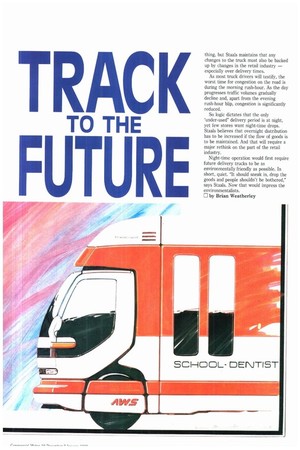• Given the task of building more efficient trucks with
Page 32

Page 33

If you've noticed an error in this article please click here to report it so we can fix it.
quieter engines, cleaner exhausts and friendlier suspensions, most manufacturers could be forgiven for leaving the small matter of infrastructure to somebody else.
After all, meeting future vehicle legislation isn't exactly a morning's work — who's got the time to solve traffic congestion?
Hans Staals, product planning director for Daf, says that truck makers cannot afford to close their eyes to what's going on out on the roads: "We'll never sell vehicles that just stand in queues — we've got to take an interest."
According to Staals, things are likely to get tougher for road transport before they get better: "The world doesn't see transport as an added value, so it becomes difficult to get money for it," he says. "If you ask people 'How much money do you want to pay for better transport?' the answer is "We don't!'."
Yet without an efficient road transport system could we still continue living the way we do? "Those countries without road transport are without wealth," says Staals. "Transport is the veins of our economy."
Faced with a thrombosis that seems to be spreading throughout our road network, the vehicle builders are in the best position to come up with the most practical solutions, despite what some environmentalists claim.
"They should allow us the creativity to meet the tests," says Staals. "It's not true that truck makers don't care; their business depends on whether we can keep transport fit. If anything, we're not involved enough," he says.
However, Daf is not going to wait to be invited to come up with the answers. In an exclusive presentation to Commercial Motor it described some of the steps it has already taken in the race to build the truck of the future.
Significantly, one of the concept vehicles, referred to as the Advanced Transportation Design (ATD), incorporates a number of engineering features which already exist.
They include a diesel/electric hybrid power pack with electric driving and braking in each wheel unit; all-wheel steering with a 180° steering angle; adaptable suspensions with extremely low-profile tyres; hydro-pneumatic suspension, electrically controlled for loading and unloading; energy recovery through regenerative braking; and multi-direction goods handling.
Sounds too far-fetched? Not for Staals: "This is no science fiction, the vehicle is 'dooable' I'm not talking about things that don't exist."
Whatever the look of the future truck, the diesel engine is likely to power it for some time, says Staals. "The electric traction motor still has a long way to go before it can be considered as a suitable power unit for a truck," he says. "I don't think we can come up with a full electric drivetrain yet — but a dual motor is certainly possible."
The environmental advantage of an all-electric truck, however, is not lost on Staals.
"ff we can make the step from a diesel engine through to electric motors with battery power we would have a zero emissions vehicle," he says.
Daf's sketchbook for the future isn't just about trucks. It also covers loads. Daf believes that a new container system needs to be devised to handle goods more efficiently. Unlike the current ISO units, the Daf system is based on a smaller standardised module or load unit measuring 2,200 x 1,450 x 2,200mm. These can be built up into different size "blocks" depending on the vehicle transporting them. In other words, the big artic moving large amounts of similar product between the supplier and manufacturer might carry as many as 26 units, while the distribution rigid delivering a variety of goods into a shop from a distribution centre would handle four, down to the home delivery van carrying one unit.
Of course, such a concept is not new. Motor Panels produced a similar advanced light truck design, again based on a multi-container concept, in the mid-eighties.
Daf's system, however, differs from others as its futuristic delivery truck has to be capable of loading and unloading its own containers. And not just off the back, but from either side and, if necessary, through the floor into a basement goods inwards area in the supermarket or factory of the future.
The ATD truck wouldn't just be capable of hauling freight. As its cargo "core" is interchangeable it could just as easily carry a healthcare module or mobile library, or any other swap body.
Speculating on future hardware is one thing, but Staals maintains that any changes to the truck must also be backed up by changes in the retail industry — especially over delivery times.
As most truck drivers will testify, the worst time for congestion on the road is during the morning rush-hour. As the day progresses traffic volumes gradually decline and, apart from the evening rush-hour blip, congestion is significantly reduced.
So logic dictates that the only 'under-used" delivery period is at night, yet few stores want night-time drops. Staals believes that overnight distribution has to be increased if the flow of goods is to be maintained. And that will require a major rethink on the part of the retail industry.
Night-time operation would first require future delivery trucks to be as environmentally friendly as possible. In short, quiet. "It should sneak in, drop the goods and people shouldn't be bothered," says Stags. Now that would impress the environmentalists.
El by Brian Weatherley




























































































